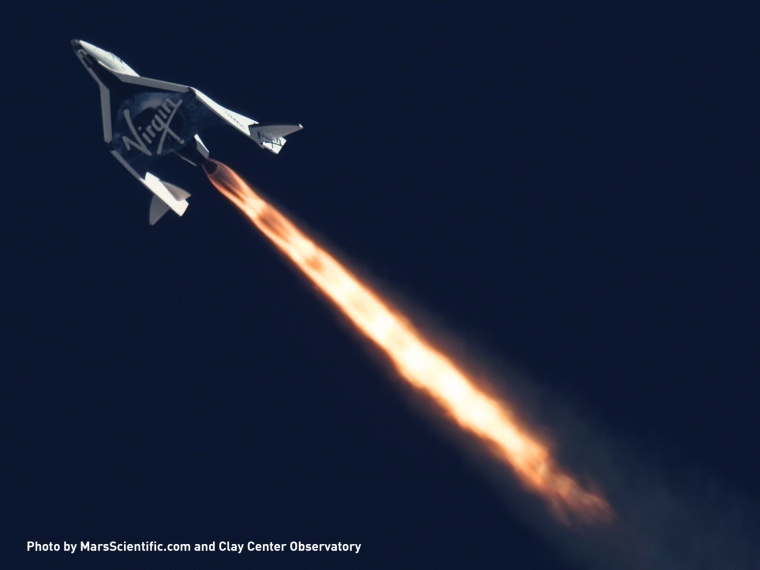GAINESVILLE, Fla. — Virgin Galactic says it's getting ready to send its SpaceShipTwo rocket plane higher and faster sometime in the next month, to take the next step toward commercial space tourism.
"We hope to go into commercial operations next year," George T. Whitesides, Virgin Galactic's chief executive officer, said here Sunday. Whitesides' presentation, delivered during the ScienceWriters2013 conference, was webcast live via Google+.
Company executives have said "wait till next year" several times before, but SpaceShipTwo has made it past a succession of ever-higher hurdles over the past few months. Its most recent test came at California's Mojave Air and Space Port in September, when the piloted craft went supersonic and demonstrated its tilted-wing re-entry system for the first time during a rocket-powered flight.
September's flight sent SpaceShipTwo to a height of 69,000 feet (21 kilometers), at a maximum speed of Mach 1.43, thanks to a rocket blast that lasted 20 seconds. Virgin Galactic and its development partners at Mojave-based Scaled Composites eventually plan to send test flights beyond the internationally accepted boundary of outer space of 62 miles (100 kilometers), but to do so the rocket engine would have to fire for an entire minute.
SpaceShipTwo begins each flight hooked beneath a carrier airplane called WhiteKnightTwo. The rocket plane drops from an altitude of roughly 50,000 feet, fires its hybrid engine, blasts its way upward, then glides back down for a landing at Mojave. It's roughly the same flight profile that was followed by SpaceShipTwo's significantly smaller predecessor, SpaceShipOne, during its prize-winning flights in 2004.
Next month's test flight would be part of a step-by-step schedule aimed at opening the way for the world's first suborbital space passengers, Whitesides said. The company's customers would be able to get out of their seats, experience a few minutes of weightlessness, ooh and ahh over the view, then strap in for the tail end of a high-acceleration roller coaster ride.
About 650 customers already have put their money down, and the company is continuing to sell tickets at $250,000 apiece. That amounts to more than $130 million committed for spaceflights so far. Whitesides noted that sales went up when Virgin Galactic announced a one-time price rise from $200,000 due to inflation.
"Some of our marketing team said, 'This is great, let's just keep raising the price every six months,'" he joked. Whitesides expects the price to come down eventually due to economies of scale.
Although the plane is being tested at Mojave, commercial flights are expected to originate from the recently constructed Spaceport America facility in New Mexico. Virgin Galactic's billionaire founder, Richard Branson, is committed to going on the first passenger flight. However, Whitesides told NBC News that research flights may precede Branson's inaugural ride.
Other nuggets from the Gainesville talk:
- In response to a journalist's question, Whitesides said "there may well be an opportunity for certain media to come along" for a free, publicity-generating space ride — if a paying passenger had to bow out at the last minute due to illness or other reasons. Such "short-notice tickets" for open seats could be made available for free to Virgin Galactic employees as well, he said.
- Whitesides said Virgin Galactic was committed to making SpaceShipTwo far safer than NASA's space shuttle fleet, which had two catastrophic failures out of 135 flights. However, he acknowledged that SpaceShipTwo may not be as safe as a Boeing 737 jet, and that accidents could happen. "I have no doubt that if there's an accident, the industry would continue. ... A big accident would have an impact on a company, and the degree to which that company would be affected would be a function of how much capital that company has, primarily, and how quickly they could get a new vehicle into service," he said.
- Eventually, Virgin Galactic aims to use rocket planes for supersonic point-to-point travel. "Nobody's attacking that problem. It's crazy, right? ... If we can put a man on the moon, we can go to Japan for lunch and come back for dinner," Whitesides said. Experts have said point-to-point rocket flights are challenging because the engineering requirements are close to the requirements for orbital flight.
More about Virgin Galactic:
- NBC announces deal for 'Space Race' reality TV
- Stephen Hawking says he's still up for a trip to space
- NBC News archive on SpaceShipTwo
Alan Boyle is NBCNews.com's science editor as well as president of the Council for the Advancement of Science Writing. CASW and the National Association of Science Writers presented the ScienceWriters2013 conference in Gainesville, in cooperation with the University of Florida. Whitesides' talk was part of CASW's New Horizons in Science briefings.
Connect with the Cosmic Log community by "liking" the NBC News Science Facebook page, following @b0yle on Twitter and adding +Alan Boyle to your Google+ circles. To keep up with NBCNews.com's stories about science and space, sign up for the Tech & Science newsletter, delivered to your email in-box every weekday. You can also check out "The Case for Pluto," my book about the controversial dwarf planet and the search for new worlds.
